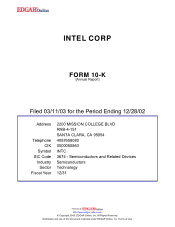Intel 2002 Annual Report Download - page 6
Download and view the complete annual report
Please find page 6 of the 2002 Intel annual report below. You can navigate through the pages in the report by either clicking on the pages listed below, or by using the keyword search tool below to find specific information within the annual report.
small business customers and emerging markets around the world.
Mobile Platform. We design our mobile products to provide notebook and laptop PC users with the performance they need while
providing wireless capability and meeting the power consumption and size constraints of mobile PCs. As with our desktop processors, we offer
mobile processors at a variety of price/performance points, allowing our OEM customers to meet the demands of a wide range of notebook PC
designs. These notebook designs include full size, thin and light, and ultra-portable. Within the ultra-portable design category, we provide
specialized low-
voltage processors, which consume as little as one watt of power on average, and Ultra Low Voltage processors, which consume
as little as half a watt of power on average. Low-voltage processors are targeted for the mini-notebook market segment while Ultra Low Voltage
processors are targeted for the sub-notebook and tablet market segments of mobile PCs weighing less than three pounds and measuring one inch
in height.
During 2002, we introduced 33 new mobile processors, providing solutions across a wide range of market segments. In January 2002, we
introduced seven new versions of the Mobile Intel® Pentium® III Processor-M and the Celeron processor based on 0.13-micron technology.
With this introduction, we transitioned our entire mobile processor product line to the 0.13-micron process, delivering the benefits of smaller die
size and higher performance to all of our mobile processors.
In March 2002, we introduced the first Pentium 4 microprocessors for mobile PCs: the Mobile Intel® Pentium® 4 Processor-M, which ran
at speeds of up to 1.7 GHz. Aimed at both the full-size and thin-and-light notebook market segments, this processor is designed to enable both
consumer and business users to take full advantage of processing-intensive applications such as audio and video encoding, digital imaging,
speech recognition, 3D content creation, computer games, and multimedia and multitasking environments. In January 2003, the Mobile Intel
Pentium 4 Processor-M was available at speeds of up to 2.4 GHz.
3
Throughout 2002 and through January 2003, we introduced the Mobile Intel Pentium III Processor-M at speeds ranging from 1.26 GHz to
1.33 GHz, as well as low-voltage versions ranging from 866 MHz to 1 GHz, and Ultra Low Voltage versions ranging from 750 MHz to 933
MHz.
Throughout 2002 and through January 2003, we introduced mobile Celeron processors at speeds ranging from 1 GHz to 2 GHz, as well as
low-
voltage versions ranging from 733 MHz to 866 MHz, and Ultra Low Voltage mobile Celeron processors at speeds ranging from 650 MHz to
800 MHz, all aimed at the mobile value PC market segment.
In January 2003, we announced our intention to introduce products based on the Intel® Centrino™ mobile technology in March 2003. This
is our first computing technology designed and optimized specifically to maximize the wireless computing experience for mobile PC users. Intel
Centrino mobile technology is a combination of a new Intel® Pentium® M processor with the related Intel chipset and 802.11-based wireless
networking technology.
Enterprise Platform.
The Enterprise Platforms Group provides microprocessors and chipsets for server and workstation systems. In 2002,
we provided building blocks for solutions across a wide range of server market segments. In February 2002, we introduced the first Intel®
Xeon™ processor for servers, based on the Intel NetBurst microarchitecture, featuring HT Technology. Server platforms using these Intel Xeon
processors, with the supporting components and operating system necessary to use HT Technology, can significantly boost system performance
for two-way systems compared to server platforms running on Pentium III processors. Aimed at two-way servers and workstations, these Intel
Xeon processors were introduced at speeds of up to 2.2 GHz. We introduced several additional versions throughout 2002, leading up to the
November introduction of Intel Xeon processors running at speeds of up to 2.8 GHz with 512 KB integrated cache. To make it easier for server
and workstation makers to build systems based on the Intel Xeon processor, we also introduced server building block products, including new
boards, chassis and RAID (redundant array of independent disk) controllers (which help to protect data by writing data across several disks).
In March 2002, we introduced the Intel Xeon processor MP at speeds of up to 1.6 GHz, bringing our Intel NetBurst microarchitecture to
servers based on four or more processors. These processors are designed to boost performance of mid-tier and back-end servers by up to 30% or
more compared to multiprocessor systems based on the Pentium III Xeon processor.
In November 2002, we introduced the Intel Xeon processor MP with an enhanced 2 MB integrated level three cache, running at speeds of
up to 2 GHz. Designed for mid-tier and back-
end servers based on four or more processors, this processor delivers up to 38% better performance
for typical server applications, compared to previous generations of the Intel Xeon processor MP.
In July 2002, we began commercial shipments of our new Itanium® 2 processors, the second in the 64-bit Itanium processor family, a line
of enterprise-class processors designed for the most data-intensive business-critical and technical computing applications. Systems based on the
Itanium 2 processor deliver up to twice the performance of first-generation Itanium-based systems.
In March 2002, we introduced the industry's first dual-processor capabilities for "ultra-dense" blade servers. Ultra-dense blade servers are
used in enterprise data centers and by Internet service providers to offer web serving, firewall protection and web caching. The Low Voltage
Pentium
®
III
processors used in dual
-
processing systems offer the small size, low power consumption and low heat that blade servers require.



















